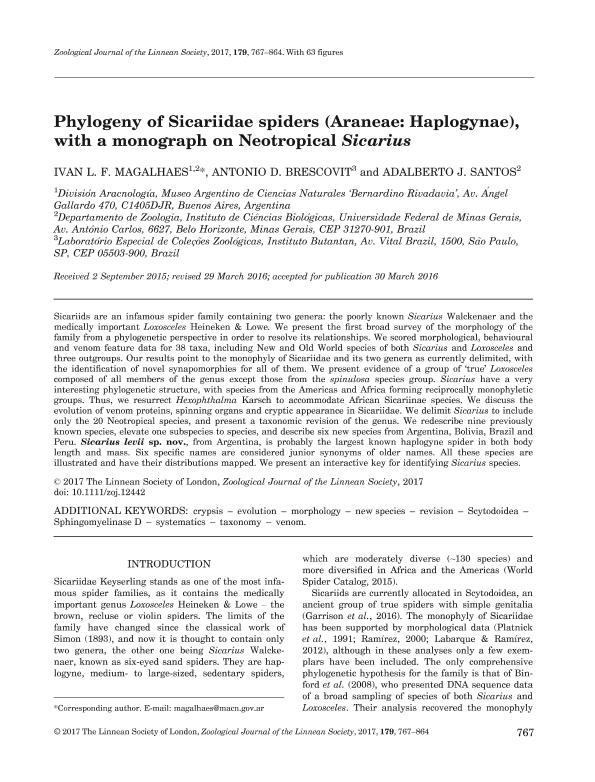Mostrar el registro sencillo del ítem
dc.contributor.author
Fiorini de Magalhaes, Ivan Luiz

dc.contributor.author
Brescovit, Antonio Domingos

dc.contributor.author
Santos, Adalberto J.
dc.date.available
2018-06-08T23:09:03Z
dc.date.issued
2017-03
dc.identifier.citation
Fiorini de Magalhaes, Ivan Luiz; Brescovit, Antonio Domingos; Santos, Adalberto J.; Phylogeny of Sicariidae spiders (Araneae: Haplogynae), with a monograph on Neotropical Sicarius; Oxford University Press; Zoological Journal of the Linnean Society; 179; 4; 3-2017; 767-864
dc.identifier.issn
0024-4082
dc.identifier.uri
http://hdl.handle.net/11336/48034
dc.description.abstract
Sicariids are an infamous spider family containing two genera: the poorly known Sicarius Walckenaer and the medically important Loxosceles Heineken & Lowe. We present the first broad survey of the morphology of the family from a phylogenetic perspective in order to resolve its relationships. We scored morphological, behavioural and venom feature data for 38 taxa, including New and Old World species of both Sicarius and Loxosceles and three outgroups. Our results point to the monophyly of Sicariidae and its two genera as currently delimited, with the identification of novel synapomorphies for all of them. We present evidence of a group of ‘true’ Loxosceles composed of all members of the genus except those from the spinulosa species group. Sicarius have a very interesting phylogenetic structure, with species from the Americas and Africa forming reciprocally monophyletic groups. Thus, we resurrect Hexophthalma Karsch to accommodate African Sicariinae species. We discuss the evolution of venom proteins, spinning organs and cryptic appearance in Sicariidae. We delimit Sicarius to include only the 20 Neotropical species, and present a taxonomic revision of the genus. We redescribe nine previously known species, elevate one subspecies to species, and describe six new species from Argentina, Bolivia, Brazil and Peru. Sicarius levii sp. nov., from Argentina, is probably the largest known haplogyne spider in both body length and mass. Six specific names are considered junior synonyms of older names. All these species are illustrated and have their distributions mapped. We present an interactive key for identifying Sicarius species.
dc.format
application/pdf
dc.language.iso
eng
dc.publisher
Oxford University Press

dc.rights
info:eu-repo/semantics/openAccess
dc.rights.uri
https://creativecommons.org/licenses/by-nc-sa/2.5/ar/
dc.subject
Crypsis
dc.subject
Evolution
dc.subject
Morphology
dc.subject
New Species
dc.subject
Revision
dc.subject
Scytodoidea
dc.subject
Sphingomyelinase D
dc.subject
Systematics
dc.subject
Taxonomy
dc.subject
Venom
dc.subject.classification
Otras Ciencias Biológicas

dc.subject.classification
Ciencias Biológicas

dc.subject.classification
CIENCIAS NATURALES Y EXACTAS

dc.title
Phylogeny of Sicariidae spiders (Araneae: Haplogynae), with a monograph on Neotropical Sicarius
dc.type
info:eu-repo/semantics/article
dc.type
info:ar-repo/semantics/artículo
dc.type
info:eu-repo/semantics/publishedVersion
dc.date.updated
2018-06-04T13:52:26Z
dc.identifier.eissn
1096-3642
dc.journal.volume
179
dc.journal.number
4
dc.journal.pagination
767-864
dc.journal.pais
Reino Unido

dc.journal.ciudad
Londres
dc.description.fil
Fil: Fiorini de Magalhaes, Ivan Luiz. Consejo Nacional de Investigaciones Científicas y Técnicas. Oficina de Coordinación Administrativa Parque Centenario. Museo Argentino de Ciencias Naturales "Bernardino Rivadavia"; Argentina. Universidade Federal de Minas Gerais. Instituto de Ciências Biológicas; Brasil
dc.description.fil
Fil: Brescovit, Antonio Domingos. Governo do Estado de Sao Paulo. Secretaria da Saude. Instituto Butantan; Brasil
dc.description.fil
Fil: Santos, Adalberto J.. Universidade Federal de Minas Gerais. Instituto de Ciências Biológicas; Brasil
dc.journal.title
Zoological Journal of the Linnean Society

dc.relation.alternativeid
info:eu-repo/semantics/altIdentifier/doi/https://doi.org/10.1111/zoj.12442
dc.relation.alternativeid
info:eu-repo/semantics/altIdentifier/url/https://academic.oup.com/zoolinnean/article/179/4/767/3076119
Archivos asociados
